Performance Evaluation: Are You Empowering Your Employees?
Written by María Eugenia Raffaele
What is an employee performance evaluation? What is it useful for? What are its advantages and disadvantages? Are some methods more effective than others? Find all the answers to your questions, and more, in this post.
Are you a leader? Then one of your key responsibilities is to do performance evaluations to set your employees up for success.
Turning this process into a truly productive one is not easy. In fact, those in leadership positions claim that they mostly resent having to carry out these evaluations because, for a long time, they’ve had – and in some cases still have – a negative effect on their staff.
Why? Simply because the wrong approach can result in frustration, distrust and attrition, other than bringing out the best of every employee.
From its definition, to its advantages and disadvantages, methods, and real examples, let’s delve into the complex nature of employee performance evaluations.
Our objective here? To help you reflect upon your practice and make this process a constructive learning experience that truly enhances professional development.
What Is a Performance Evaluation? What Is It Useful For?
Let’s start by giving a straightforward definition: The employee performance evaluation or performance appraisal (we’ll use both terms instinctively throughout the article) is a formal procedure companies use to measure and account for an employee’s performance and results based on their job responsibilities and goals.

A performance evaluation, however, implies much more than simply conducting formal evaluations. In fact, talent management is a more comprehensive concept and its objectives will depend on each organizational culture’s, mission, and vision.
For example, more rigid and traditional companies see formal evaluations as an end in themselves, with the simple aim of measuring performance and improving results.
On the other hand, human-centric organizations that put the needs of individuals first, have a more holistic view of performance evaluation, and consider it an ongoing process that helps them boost people’s professional and personal experience.
Why do we make this distinction in terms of organizational culture? Simply because the mission and values of each company are essential to determine the why, the how, and the results of a performance evaluation.
World of Work Trends
Especially organizations with people-centric cultures are replacing traditional formal performance appraisals by performance management programs based on more informal ongoing feedback and greater participation.
How to Conduct an Employee Performance Evaluation
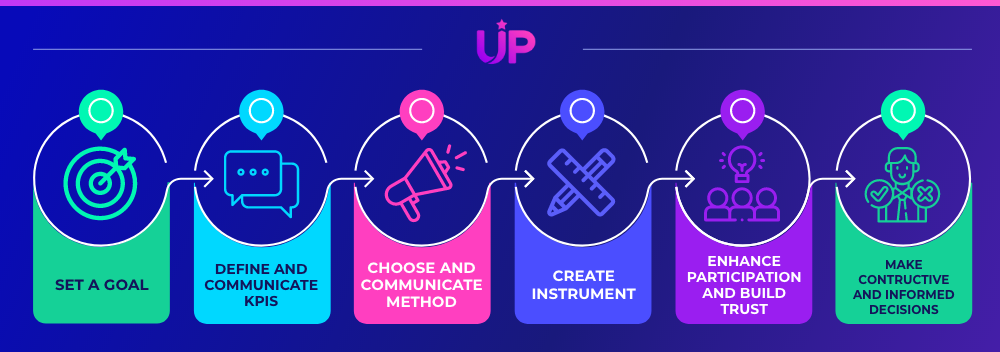
You must have noticed that the approach will vary from culture to culture. However, regardless of the method – or combination thereof – each company chooses, the approach to any performance appraisal requires these steps:
1. Ask yourself: What goal do I have in mind?
What do you want to achieve through performance management?
2. Define indicators, competencies, and objectives.
Allow your employees to participate throughout the process – from the moment you define KPIs, OKRs and SMART Goals with them, onwards. Make sure their work and personal goals are aligned with your company’s.
- Find out what KPIs, OKRs and SMART Objectives are and how to define them with your employees.
- Give HR key tools to make the best decisions on talent performance.
3. Choose the Method
We will detail the different evaluation types and methods later, but keep this in mind along the article: you do not necessarily have to choose just one. In fact, seeing performance evaluation as a wide and informal concept, that implies a combination of various practices, is the best approach you can think of.
4. Create the Instrument
Once you define the indicators and the method, the next step is to define and create the evaluation instrument. At this point, there are multiple application services and the choice of the right one will depend on your goals and your company culture.
Especially in this remote work context, building a digital culture and fueling performance management with the right digital solutions is essential. The greater the visibility a company gets of each employee- their needs, concerns, feelings, strengths, and opportunities – the more successful and consistent their growth will be.
5. Encourage Participation and Follow-Up
This stage in the process of employee performance evaluation is key.
To obtain truly useful results and information for the professional development of your teams, everyone should get visibility of the process and be actively part of it.
We cannot make constructive decisions if they are based on results of subjective and sporadic evaluations. So, get all participants involved and give ongoing feedback to make adjustments on the way.
6. Make Informed Decisions
Once holistic and objective information on your teams’ progress is obtained, you have the valuable opportunity to analyze it together with your employees and make smart decisions. Align objectives, and empower your staff to be the protagonists in their professional development.
Tip
This is the most defining moment of all. If you count with a digital solution that gives full visibility of your people, then decision making runs smoothly. Your employees also need to evaluate the impact of their performance, so share all your information with them (metrics, feedback, processes, concerns, strengths, challenges, etc.), and plan a 1: 1 meeting to come up with a professional development strategy together.
What should an employee evaluation form include?
An employee evaluation form is basically a performance template that includes the criteria to be evaluated. Each company will create its own employee evaluation template or tailor its performance appraisal, depending on the method/s leaders choose, and the indicators, procedures, and goals they intend to analyze.
This free employee evaluation form template in word is simply a guide and you don’t need to use it just as it is. In fact, today, most companies use digital solutions and performance evaluation software that allow them to set criteria and procedures in a more agile and personalized way.
What are the most common types of performance evaluation?
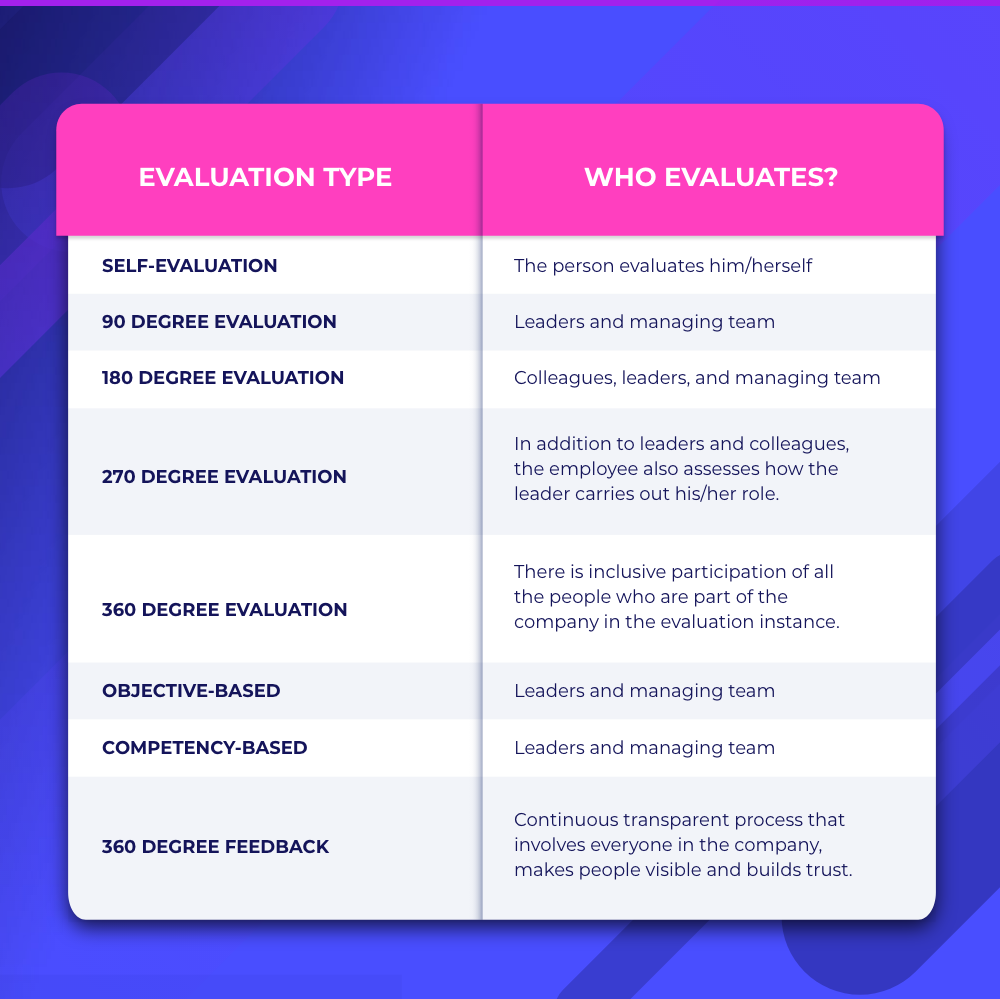
Understanding each type of job evaluation and most common methods is the first big step in developing successful performance management.
Self-evaluation Method
In a self-evaluation, it is the employee who performs, according to certain pre-established indicators and parameters, an assessment of their own performance. The objective is to encourage self-awareness of one’s own strengths, challenges and opportunities, in order to make adjustments that align him with the mission and objectives of the organization. If you’re looking for self-evaluation examples, there are plenty of free performance review templates you can use as a guide.

90 Degree Performance Evaluation Method
As you can see from the table above, the 90 degree type of evaluation implies that leaders are the only ones who carry out the evaluation of the people under their responsibility.
Here, specifying employee performance evaluation survey questions help managers and supervisors to give actionable feedback on specific aspects of employees’ work. Based on their opinion and observation of strengths and opportunities, they guide a professional career plan for each employee.

180 Degree Performance Evaluation Method
Also called Peer Review, in the 180 ° evaluation, apart from the manager, colleagues also intervene as evaluators of each employee.
In this type of evaluation, peers are key participants because they share their colleagues’ day-to-day – from responsibilities, to opinions, plans, and ways of approaching tasks. Therefore, their objective look can significantly contribute to the professional development of their teammates.
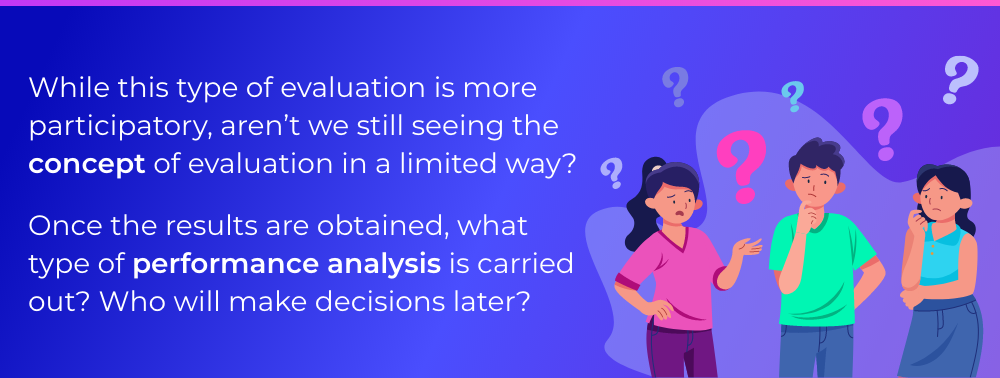
270 Degree Performance Evaluation Method
In a 270 ° performance evaluation, the members of each team assess how their leader or supervisor carries out his/her role.
Receiving an evaluation of our teams can be beneficial and constructive, but in general there is resistance on the part of employees to give an honest opinion about a superior. This is why many companies choose to facilitate the process by doing it anonymously, so that the team can comfortably express their view.

360 Degree Performance Evaluation Method
In this type of evaluation, there’s a more comprehensive vision of each employee, since everyone takes part in the process. In general terms, although the objective of the 360 ° evaluation is to provide a more balanced view of each individual, this is still a formal and infrequent process that represents limitations and challenges for any organizational culture – especially when trust and fluent communication are not pillars of the company.
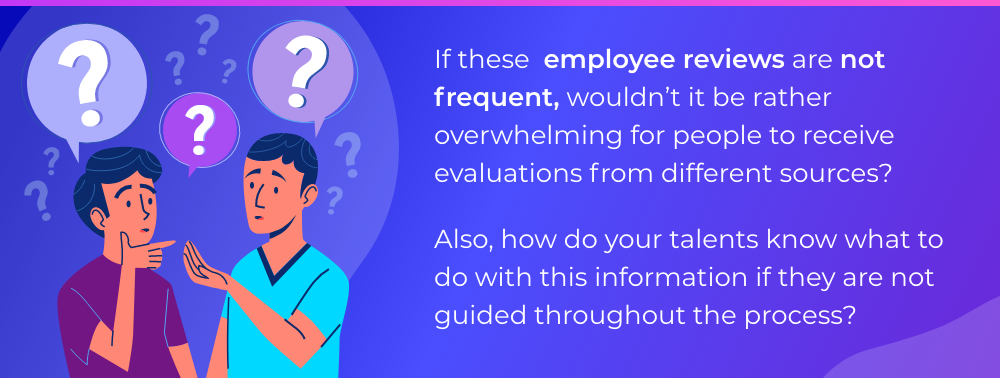
360 Degree Performance Feedback Method
Even today, giving and receiving feedback seems to be one of the greatest challenges in most organizations. In fact, according to a Gallup study only 26% of people find this practice helpful.

Feedback 360 is capable of much more than simply evaluating your staff. It’s a method that, in addition to promoting and improving professional development, creates a committed work environment based on values and trust.
Unlike a type of 360-degree annual evaluation or report, 360-degree feedback is a continuous process that involves everyone in the company, gives people visibility, and makes them feel more valued.
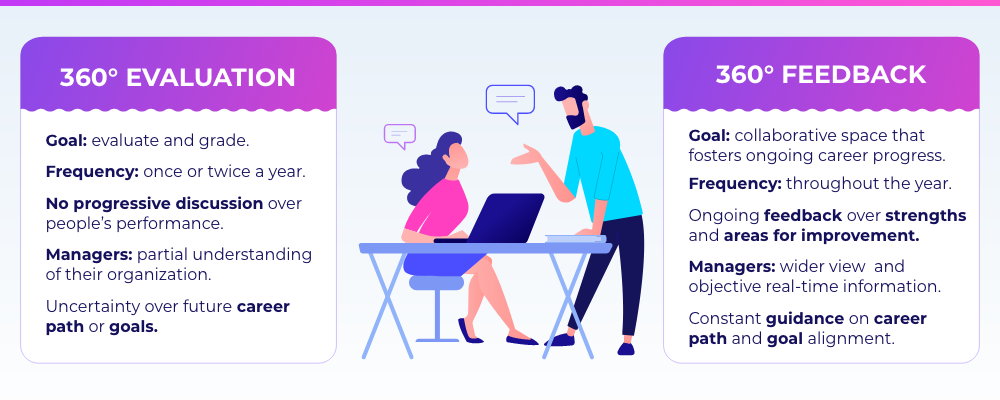
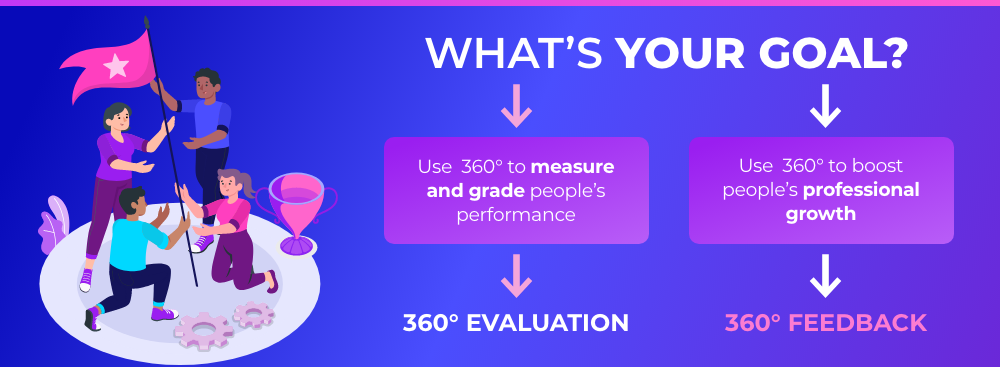
Objective-Based Performance Evaluation Method
This type of performance evaluation began to be used in the 1980s. Here, managers and/or leaders establish objectives for their teams and employees are scored based on their achievement. This method implies monitoring, controlling and evaluating the organization’s goals.

Competency-Based Performance Evaluation Method
Over time, professional development has gained more importance worldwide which is why the competency-based performance appraisal was born. The aim here is to detect people’s strongest competencies and skills, and enhance them through a professional development program created based on evaluated needs.
The key step is to determine what competencies we want to analyze, that is, what criteria we’ll use to assess our talents.

What is the best method for performance evaluation?
Truth is no method in itself is best. Although there are some formal practices that are already obsolete nowadays, when applied individually, no performance appraisal is enough to address performance management successfully.
So? Let’s look at it like this: The best performance appraisal is based on a holistic process that draws on a combination of various appraisal practices.
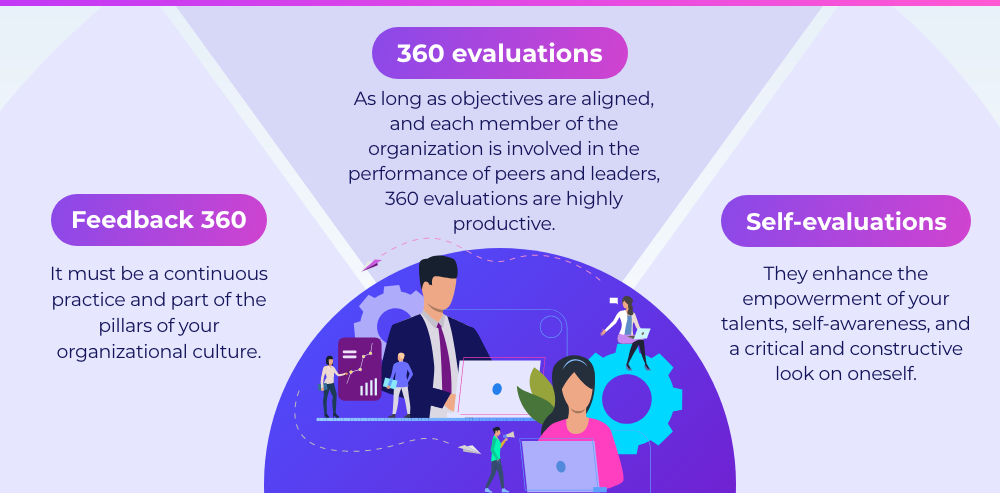
We suggest you combine these practices with effective communication, a clear definition of values and competencies, and relationships based on trust. This way, your people will feel valued, empowered and 100% involved with their professional development and your company.

So, before you choose your performance evaluation path, ask yourself:
- What ‘s my goal? Simply evaluate the work of my teams, or empower them to lead their own professional growth?
- Do I seek to focus on a chain of command that separates my teams from leadership, or do I want to collaboratively set clear expectations and goals with my employees?
- Is trust and emotional bonding part of the day-to-day experience?
TIP
Especially in times of remote leadership, promoting continuous learning, authentic collaboration, and self-awareness in all your employees can be a great challenge, but it is possible to achieve this by putting their needs and concerns first. It all depends on your organizational culture and the path you choose to take…
What are the advantages of performance evaluations?
The benefits of performance evaluation can be many, but there are also multiple disadvantages, depending on your approach and your vision of it.
When approached correctly, as a process of continuous training, support, recognition and feedback, performance appraisals can have many advantages.
#1: We promote self-awareness in our employees by helping them to recognize and understand:
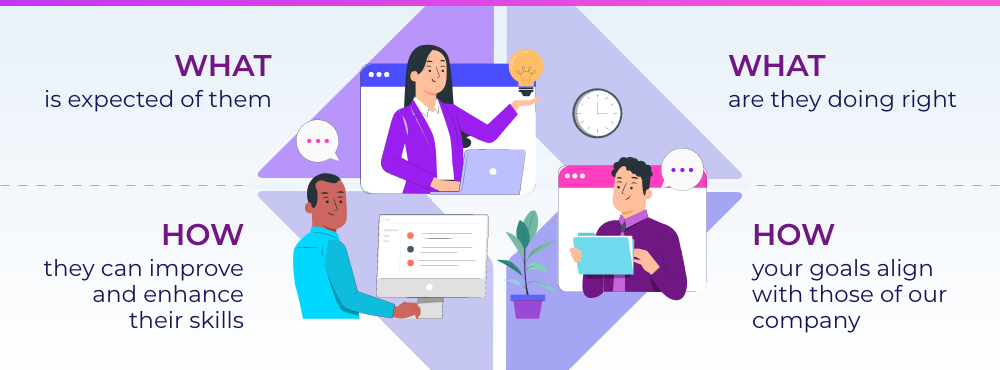
TIP
Allowing each person to recognize and understand what is expected from them is essential.
Whichever method you choose as a performance evaluation tool, be sure to engage each member of your teams and make OKRs and the SMART Methodology your best allies to boost the growth and performance of all your staff!

#2: We achieve greater visibility of our people’s daily experience.
Before you continue reading, ask yourself: Can we evaluate without really knowing the people that work in our company?
Getting involved with our talents’ daily experiences, processes, and emerging needs is key to achieve successful performance management.
#3: We can recognize top talents with high performance and cultural ambassadors more easily.
Reflection
Did you know that recognition is part of the emotional connection achieved through continuous and constructive feedback?
When considering a job performance evaluation, we invite you to reflect on the importance of recognizing your talents throughout the process.
Results? Stronger bonds and a greater sense of belonging.
#4: Decisions are made on time – attention to needs, correction and alignment of behaviors are naturalized and become part of everyday experience.
#5: We improve the communication of expectations, making our employees more involved in each process.
#6: We promote continuous learning, growth, and development, which leads to greater staff commitment and motivation.
The future of work is not ours – it is Generation Z’s. They are already stepping onto the world of work scenario and guess what? They seek to understand themselves and enhance their personal and professional development.
Changing the focus of what a performance evaluation is, and seeing it as a continuous process of feedback and growth opportunities, is key to attracting this new generation and enhancing their skills.
And what about the disadvantages of performance appraisals?
When organizations approach their performance management through a single, infrequent, formal performance appraisal method, all they will get are scores based on fixed rating scales, which does not provide any professional growth.
Outcomes?
#1 The opportunity to progressively face challenges in a collaborative and participatory way is lost.
#2 Leaders and managers get a partial understanding of organizational dynamics.
#3 If there isn’t a solid culture with strong connections among people, receiving a grade once or twice a year can be overwhelming and threatening for teams, resulting in attrition and less productivity.
#4 If communication and collaborative feedback are not part of the daily experience of the organization, an employee performance evaluation as the only method can generate mistrust and conflicts among colleagues.
#5 People can’t understand where to direct their efforts and they don’t feel valued or truly part of the organizational culture.
# 6 It is more complex for leaders to obtain concrete and representative data over time. This could cause a lack of continuity in people’s professional development.# 7 If objectives are not mapped clearly, employees start experiencing lack of confidence in themselves and less commitment to the company.

Performance evaluation: examples that will inspire you
In the world of work, there are countless real-life evaluation examples that inspire companies around the world to evolve in their performance management.
Today, organizations with employee-centric cultures that foster collective growth based on human relationships have already completely eliminated traditional job performance reviews. In fact, they have listened to their talents closely, and over time, they began to carry out a more informal approach based on continuous feedback and in one-on-one meetings.
Let’s get inspired by examples of great companies with great cultures. Shall we?
Employee Performance Evaluation: Example # 1
Adobe – Mountain View, California, United States
Donna Morris, senior vice president of HR at Adobe, found their annual job evaluation process complex, bureaucratic, and burdensome because it was time-consuming and did not provide productive tools for employees.
In 2012, Adobe became an example of transformation. She left behind the performance appraisal method based on annual evaluations and began using a frequent feedback and employee review system.
Results? Managers and employees aligned goals effectively and improved performance regularly and collaboratively.
Employee Performance Evaluation: Example # 2
A few years ago, Globant saw the need to rethink and transform its performance management approach. As a human, people-centered culture, it adopted StarMeUp – a solution that helps the company promote and empower continuous professional development. Globant does not choose a single method or form. Its vision is a holistic, human, people-focused process, which is fueled by the combination of several practices such as 360 feedback, 1: 1 meetings, goal alignment, and specific formal instances – all based on emerging needs.
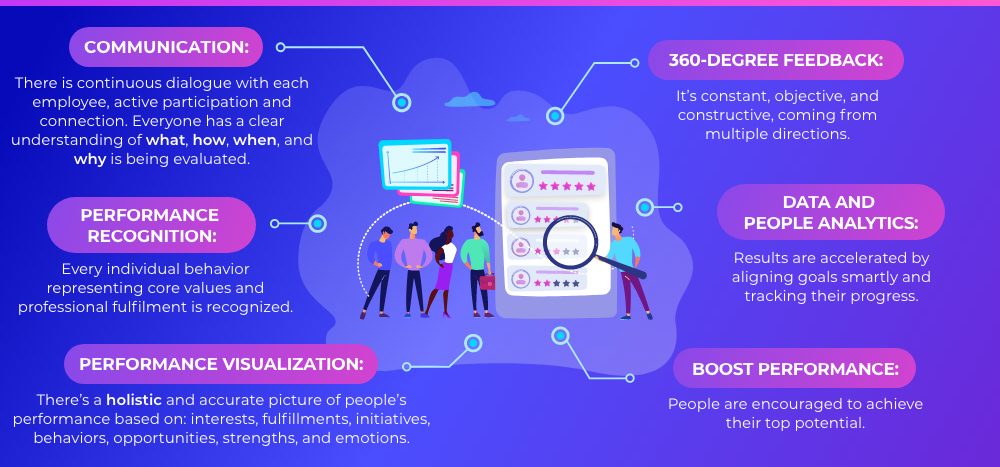
“With StarMeUp, all this user-generated content – from a celebration of an action, to a recognition, feedback, or survey result – allows us to really know all our employes and make data-based decisions that help people achieve their objectives and grow professionally “
Guibert Englebienne – Co-Founder & CTO at Globant & President of Globant X
Employee Performance Evaluation: Example # 3
Juniper Systems – Logan, Utah, United States
In 2009, Juniper started to redefine its vision, brand, values, and expectations from their employees.
The annual performance review was one of the points that needed improvement, since employees needed more regular feedback, with no surprises. Their performance reviews and evaluations were unrelated.
What path did they take? They eliminated forced old-fashioned ratings and adopted a solution that was more in line with their new perspective on performance management.
Employee Performance Evaluation: Example # 4
Microsoft – Redmond, Washington, United States
For years, Microsoft has used a job performance appraisal approach that encouraged employees to compete with each other rather than build a collaborative Microsoft, which is something CEO Steve Ballmer was trying to push ahead of his retirement.
In 2013, Microsoft revamped its performance management by eliminating formal and subjective evaluation, replacing it with an ongoing feedback process, with emphasis on team collaboration and professional development.
Final conclusions and takeaways
As you can see, the concept of employee performance evaluation is very broad, and the approach to performance management has significantly evolved over time.
Today, technology brings us closer together and sharing experiences with other corporations allows us to continually reflect and transform ourselves.
We hope this article reminds you that your employees are the most valuable assets in your organization. Yes, each of them – and you too – have strengths and challenges ahead, but above all you are all human beings with emotions, aspirations, projects, and concerns.
So when it comes to defining or redefining your performance management, you must have noticed that employee evaluation templates, and forms with rubrics and grades will give you nothing but a partial and biased look at your employees. So, put your talents first. Choose digital solutions that allow you to have greater visibility, and observe them, listen to them, and navigate the future of your company together.
What about you then? What’s your experience with performance evaluations in your company? Are you ready to maximize the performance and journey of your talents? Remember that we are always willing to give you guidance to make decisions that promote constant human and organizational growth.